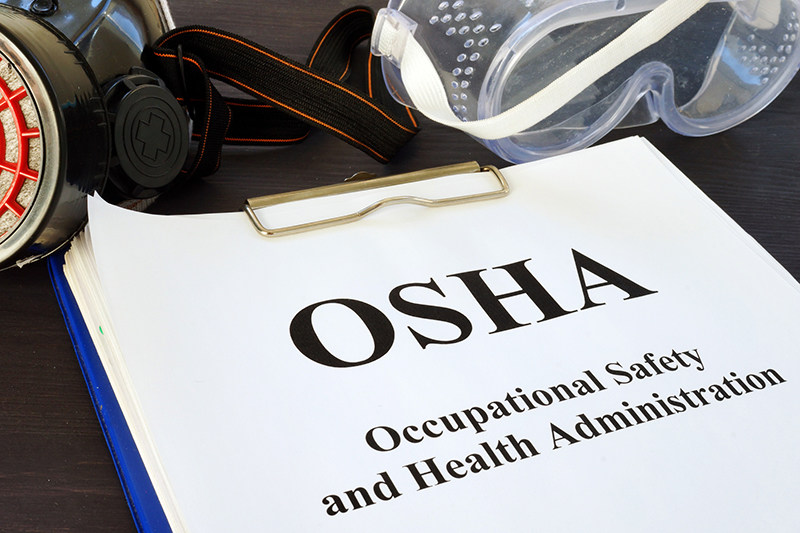OSHA’s Top 5 Cited Standards
Every year the Federal Occupational Safety & Health Administration (OSHA) releases a list of the ten most-cited violations it uncovers every year. These standards are meant not only to ensure employee health and safety, but they’re also essential to running your business smoothly and efficiently. OSHA conducts inspections every year, often without advance notice, to ensure compliance. Non-compliance can not only puts workers at risk, but can also carry heavy fines.
In the Fiscal Year 2015, OSHA conducted 35,820 Federal and 43,471 State Plan inspections. Here are the Top 5 most-cited Standards and the total penalties assessed with each:
1. 1926.501 – Fall Protection
Fall protection safety measures include guardrail systems, barricades and covers, safety net systems, and personal fall arrest systems that prevent workers from injuring themselves due to either falling from a height themselves or being hit by a falling object.
Citation Breakdown for the 2015 Fiscal Year:
Inspections With Violations: 7,005
Total Citations: 7,309
Average Citations Per Inspection: 1.04
Total Penalties Assessed: $24,016,109
Average Penalty Amount: $3,286
2. 1910.1200 – Hazard Communication
The Hazard Communication Standard ensures that all hazards of imported or produced chemicals are properly transmitted to both employers and employees. Compliance with this standard entails a comprehensive hazard communication program to promote proper chemical handling, labeling, and storing. In the Standard, OSHA outlines several means of accomplishing and implementing such a program:
- developing and maintaining a written hazard communication program for the workplace, including lists of hazardous chemicals present
- labeling of containers of chemicals in the workplace, as well as of containers of chemicals being shipped to other workplaces
- preparation and distribution of safety data sheets to employees and downstream employers
- development and implementation of employee training programs regarding hazards of chemicals and protective measures.
Citation Breakdown for the 2015 Fiscal Year:
Inspections With Violations: 3,213
Total Citations: 5,809
Average Citations Per Inspection: 1.81
Total Penalties Assessed: $3,425,710
Average Penalty Amount: $590
3. 1926.451 – Scaffolding
The Scaffolding Standard oultines OSHA’s required safety measures, load-bearing design requirements, and construction and material methods for construction scaffolding. The Bureau of Labor Statistics’ Census of Fatal Occupational Injuries reported 54 fatalities in 2009 from scaffolds (source).
Citation Breakdown for the 2015 Fiscal Year:
Inspections With Violations: 2,073
Total Citations: 4,576
Average Citations Per Inspection: 2.21
Total Penalties Assessed: $9,334,212
Average Penalty Amount: $2,040
4. 1910.134 – Respiratory Protection
The Respiratory Protection Standard acts to protect employees and employers alike from harmful fumes, vapors, smoke, or otherwise harmful substances that may be inhaled. This Standard pertains to General Industy, Shipyards, Marine Terminals, Longshoring, and Construction. The Standard requires that employers develop and implement a written respiratory protection program as well as required worksite-specific procedures and elements for respirator use.
Citation Breakdown for the 2015 Fiscal Year:
Inspections With Violations: 1,675
Total Citations: 3,664
Average Citations Per Inspection: 2.19
Total Penalties Assessed: $2,730,941
Average Penalty Amount: $745
5. 1910.147 – Lockout/Tagout
Lockout/Tagout (LOTO) systems are commonly used in industry and research settings to ensure that potentially dangerous machines are properly shut down during maintenance, and cannot unexpectedly start up again until service is complete. (This is referred to in the Standard as the “control of hazardous energy”). Lockout devices can comprise a manual disconnect switch or circuit breaker for electrical devices, or a valve and bleed system for hydraulic or mechanical devices. Lockout systems are always combined with a Tagout process, which involves using a label or indicator that includes the following information:
- Why the lock/tag is required
- Time of application of the lock/tag
- The name of the authorized person who attached the tag and lock onto the system
A proper LOTO system is essential to a safe work environment.
Citation Breakdown for the 2015 Fiscal Year:
Inspections With Violations: 1,916
Total Citations: 3,348
Average Citations Per Inspection: 1.75
Total Penalties Assessed: $9,543,740
Average Penalty Amount: $2,851
The safety standards outlined by OSHA are only effective if properly implemented. Many of the Standards listed above provide guidelines for developing and implementing proper safety inspection practices. A proper inspection program that is conducted on a regular basis can quickly identify potential hazards and violation, and provide proper documentation of compliance in the case of an audit.
With Mobile Inspection, you can create your own checklists and inspections, schedule and manage inspections from the internet, and download custom PDF reports including pictures and GPS locations for your records. Contact us to learn how Mobile Inspection can help keep you compliant with OSHA standards.

 800.259.6812
800.259.6812 



